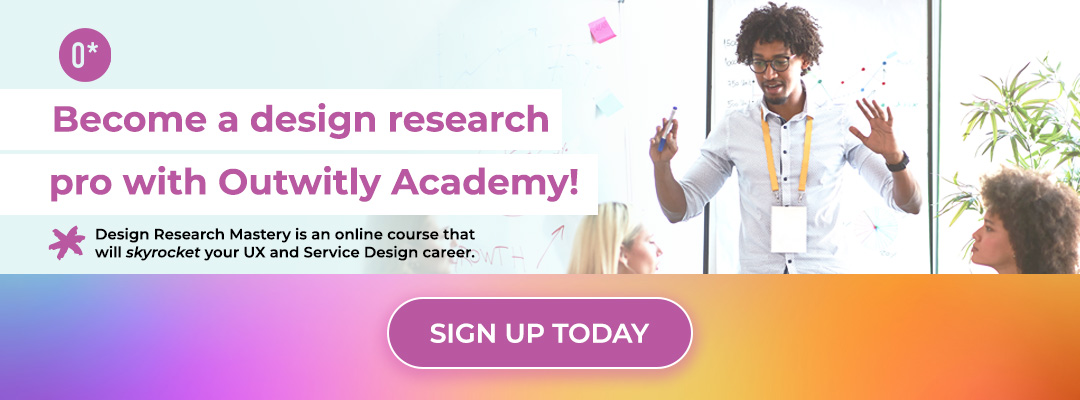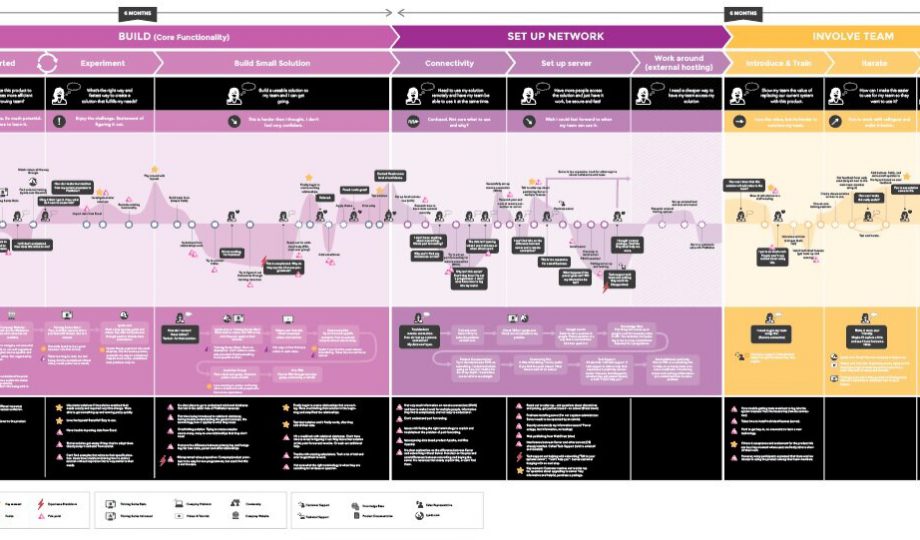Written By: Micaela Dixon
Since the start of this year, Outwitly has delivered free monthly webinars to our community of designers and researchers, educating our audience on UX, service design, design research, and more. Recently, we hosted a webinar that expanded our UX horizons and dove deep into the hot topic of AI and its integration with user experience. Today’s blog post comes from a previous webinar, “User Experience in AI: People-Centered Principles and Practices,” hosted by UX Designer and Researcher Micaela Dixon.
With AI advancing at incredible speeds, it can feel difficult to keep up and embrace AI to its full potential. That’s why we turned to Micaela Dixon, Founder of @UXDesignForAI, to walk us through the fundamentals of AI, how these technologies intersect with UX design, and how you can work with AI in a way that prioritizes a human-centered approach. Make sure to check her out on Instagram, @UXDesignForAI!
Before unpacking and exploring the key takeaways we learned during this inspiring event, sign up for our newsletter to be the first to know about our upcoming webinars!
In this blog post, we’ll explore:
- AI in UX: Foundations for Designers and Researchers
- AI Fundamentals: Types of AI and AI Interfaces
- 6 Best Practices for Human-Centered AI Design
AI in UX: Foundations for Designers and Researchers
If you’re a practitioner, product designer, UX researcher, or somewhere in between, and you’re wondering why you should learn AI, you’re in the right place. We understand that there’s always something new to explore, from emerging technologies to hot topics, so why prioritize AI? The answer is simple: AI is here to stay. It’s not just a passing trend or a fleeting buzzword. AI is integral to the future, especially for those of us in UX.
If you search LinkedIn for your current or dream job, you’ll notice that many listings require knowledge of AI or experience with AI tools. As your role in human-centered design evolves, you’ll increasingly work with more AI-powered products and services. Imagine trying to design for AI-driven technologies without understanding how they work!
While companies may not expect you to be a data scientist or an AI expert, a solid grasp of AI fundamentals and how to work with them will make you a valuable team member and enhance your career prospects.
Now, you may better understand why AI is important for you as an individual and how AI tools will benefit your daily life, but why is AI important when it comes to UX?
The answer is simple: AI is transforming the way we experience technology! Today, many services, products, and websites integrate AI into their operations. AI not only impacts user experience but also collects and uses user data in unprecedented ways.
Naturally, AI raises many ethical concerns, and as UX professionals, it is our responsibility to champion and advocate for human experiences, ethics, and emotions. We must be at the forefront of AI adoption and get involved in conversations about the technology’s functionality, robustness, intentions, and presentation.
AI Fundamentals: Types of AI and AI Interfaces
The world of AI is so vast, and it seems to be expanding every day, but that shouldn’t discourage you from exploring all the possibilities and tools within this field. Yes, knowing where to begin can be overwhelming and difficult, which is why we’re here to simplify things and build a strong foundation for you to kick off your AI journey.
AI and UX expert Micaela Dixon was once in your shoes, too, feeling overwhelmed and unsure how to start learning AI. She also began by understanding the bare basics of AI and asked herself, “What do I need to know about AI?” After years of research and experience working with AI, she’s gathered the fundamentals you must know: the types of AI and the types of AI interfaces.
Types of AI
- Computer Vision: Computer vision is just like its name suggests; the computer’s vision tries to replace and simulate the vision of the human eye. This intelligent algorithm is programmed to recognize products, faces, people, and objects. You come across computer vision whenever you unlock your iPhone using Face ID! You might also encounter computer vision AI while browsing through your camera roll. For example, Apple’s “People” feature recognizes faces and sorts photos of your friends and family into folders. This AI identifies facial patterns and features, automatically labelling each face and organizing your images accordingly.
Image Source: https://machinelearning.apple.com/research/recognizing-people-photos
- Machine Learning: This type of AI also appears frequently in our day-to-day life, if not the most frequently! If you’re like us and love to unwind at the end of the day with some Netflix binge-watching, then you are definitely familiar with machine learning AI. Netflix is a great example of this type of AI, with their machine learning your watching behaviour and providing recommendations. In short, the AI takes in your behavioural information (what shows and movies you watch), sorts it into recognizable patterns (you love horror movies), and then uses these patterns to anticipate what you want to watch next! The AI is learning your behaviours using the data provided to understand and predict what you’d like to see.
- Natural Language Processing: The third type of AI is natural language processing. You may recognize this if you use ChatGPT or Google Translate. This type of AI interprets large amounts of language data (textual or spoken words, sentences, and phrases), analyzes, codes, and sorts it, and translates it back to us in a language we can understand. Overall, natural language processing AI helps computers better understand, interpret, and respond to human language in a meaningful and useful way!
Types of AI Interfaces
Think of each type of AI as the ‘brain’ of the technology, while the interface represents the ‘body.’ In other words, the AI interface determines how the technology will present itself, appear, and interact with you and your users.
- Conversational: AI with a conversational interface will simulate exactly that: conversations. These interfaces can be text-based interactions, such as chatbots, or voice-based interactions, like virtual assistants.
- Visual: Visual AI interfaces interpret and process visual data, enabling users to interact with technology through images, videos, and animations. This type of interface powers tools you might be familiar with, such as facial recognition, object detection, augmented reality, and visual search.
- Predictive: Another common AI interface is the predictive type. Again, this is our friend Netflix, which uses our historical behavioural data to make personalized predictions and recommendations. Not only can predictive AI interfaces help us out for movie night, but they can also help us predict and forecast business sales and the performance of various products or services.
- Gesture and Motion: These interfaces use sensors to detect and interpret movements and gestures, allowing users to interact with devices without needing to touch or prompt them! The AI can recognize hand signals, body movements, or facial expressions to carry out commands, control applications, or navigate systems. These types of interfaces also help power location-tracking technologies like Google Maps.
You can thank gesture and motion AI interfaces for the fireworks, confetti, and emojis that pop up during Zoom calls when you hand gestures toward the camera!
Image Source: https://www.digitaltrends.com/mobile/how-to-use-ios-17-facetime-gestures/
6 Best Practices for Human-Centered AI Design
Now that we’ve covered the basics of AI let’s look a little deeper into designing AI products and services with the human-centered design (HCD) philosophy in mind. How can we work with AI to ensure our users are cared for and receive the best experience possible?
Here are the six best practices to ensure people remain at the forefront of AI design: Research, transparency, clarity, guided prototyping, feedback, and user trust.
Let’s explore each practice in more detail!
1. Research: As with any project, research must always come first, and this is especially true when designing for AI products. Conducting thorough, diverse, and thoughtful research before starting the design process will help ensure that the AI product and technology genuinely meet your users’ needs. AI has the potential to assist users in various ways, so it’s important to narrow down the exact areas where users need support.
Once your research is complete, you’ll be able to train the AI using diverse, accurate data that will enable the intelligence to best assist and serve your users with accuracy and minimal bias. Plus, with research defined ahead of time, your team will have a clearer, more defined plan on how to best use and interpret any data collected by the AI.
In other words, UX research = diverse data collection = fewer biases = accurate outputs = amazing products and experiences!
2. Transparency: As we mentioned, there is a lot about AI that we don’t quite understand – there is simply so much to learn! The collective sense of unfamiliarity we all feel about AI highlights why transparency is essential when designing for AI.
When faced with new, unfamiliar technologies like AI, users can feel increasingly hesitant, on edge, and uncomfortable, which can negatively affect their experience and/or the customer journey. To ease any worries or concerns, ensure there is clear, straightforward, and easy-to-understand information about the specific AI being implemented. Explain to your users what they can expect from the AI and how it will assist them, and be transparent about how data is used and collected.
As Micaela put it, “There is nothing worse than giving your data to a product and having no idea how it is being used.” We couldn’t agree more!
3. Clarity: Another important practice to consider when designing is ensuring the AI is presented to the user in the clearest way possible. Showing your user that the feature is AI-powered can be as simple as using a stand-out colour, adding a robot icon, or other imagery that catches the eye.
Many AI technologies we encounter today tend to use the colour purple or include small sparkle details around their product. These details may seem insignificant and minor, but these simple additions subtly remind users of the technology they are using.
View this post on Instagram
4. Guided Prompting: Again, when faced with unfamiliar features and technology, sometimes our users need a little push in the right direction before they start using the product. One way to do this is by including guided prompting and suggestions in the AI design.
Guided prompting helps direct users to specific types of queries or commands, making it easier for them to achieve desired outcomes. By offering these prompts and suggestions, the AI can better enhance user experience, reduce confusion, and ensure accurate, productive, and effective interactions.
ChatGPT is a great example of an AI tool that includes guided prompting. Before typing a request into the bot, users are faced with four different prompts they could ask the AI. Regardless of whether the user uses these suggestions or not, the key takeaway here is that it educates the user on the scope, depth, intelligence of the AI, and how users should phrase their request.
Image Source: https://openai.com/chatgpt/
5. Feedback: Feedback serves as a crucial link between users and the product, allowing us to continually advance and improve services. You may have heard the term’ feedback loop,’ which is crucial for understanding how AI learns from feedback.
AI feedback loops refer to the process of an AI technology receiving feedback from a user, using that information to improve itself, and then receiving more feedback, and the loop continuing. This process is constantly happening, with AI technologies able to adapt, respond to, and learn from feedback instantaneously.
6. User Trust: Last but certainly not least, the final important practice for AI design is establishing user trust. When users trust a product, service, or technology, their experience can go from daunting, confusing, and unfamiliar to comfortable, understandable, and reliable. These positive feelings amongst your users can increase user retention and significantly impact customer satisfaction and customer experience.
Here are two ways to establish user trust within your AI design:
- Credibility: Establishing credibility is one effective way to build user trust in your AI design. Be sure to provide your users with reliable sources so they can independently verify and confirm the information. This transparency reinforces your product’s reliability and reminds users to think critically about what they read and use because AI can still make mistakes.
- Control: Another way to establish user trust is by granting your users control over their experience. Consider including buttons such as “Continue generating” and “Stop generating” to help your users manage the AI output and feel safe and secure by knowing they can stop and restart the technology as they please.
We’ve said it once, and we’ll say it again: AI is here to stay. But remember, AI is nothing to be afraid of! Instead, it should be something that excites and inspires you!
Now that you have a solid foundation and a better grasp of how to design for AI products and services, you’re ready to help shape future technologies for the better, with people, emotions, and experiences at the forefront.
If you want to learn more about UX and AI, head over to Micaela’s Instagram @UXDesignForAI, and stay in the loop by subscribing to the Outwitly newsletter here.
The future is now!









